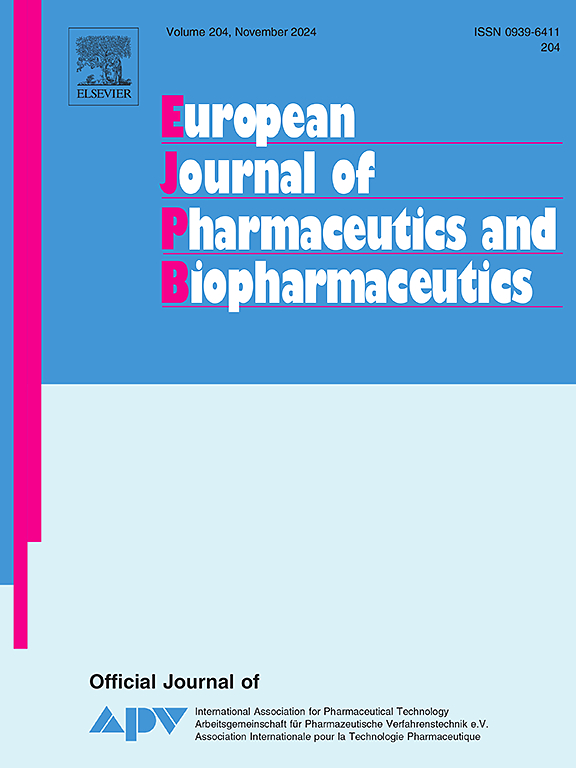Improving accuracy in food effect predictions: Application of in-vitro absorption experiments as a useful tool for the evaluation of ten drug products
IF 4.4
2区 医学
Q1 PHARMACOLOGY & PHARMACY
European Journal of Pharmaceutics and Biopharmaceutics
Pub Date : 2025-04-16
DOI:10.1016/j.ejpb.2025.114722
引用次数: 0
Abstract
Predicting the magnitude and direction of food effects on oral drug delivery can be challenging, especially for compounds with absorption limited by changes in the permeation rate. Currently available in-vitro tools assess the impact of increased bile flow and food on drug solubilization, potentially leading to increased absorption under fed conditions. However, the presence of bile can sequester the drug within bile/food colloids, reducing free drug availability and resulting in unanticipated absorption. The aim of this study is to explore the application and outcome of a combined dissolution/permeation (MacroFLUX™) assay of ten drug products for a more accurate prediction of clinical food effects in the context of given dose and formulation. The ratio of the fed-to-fasted dissolution and Flux were used to correlate each experimental model to clinical food effect in humans. Assessing the flux across a biomimetic artificial membrane provided superior predictability over dissolution alone. Food effects were predicted accurately for 60% of compounds within 1.25-fold based on flux analysis, while dissolution analysis only predicted 30% of compounds evaluated. The most interesting outcome is that dissolution did not pick up on any of the negative food effects. Notably, the study revealed that the common assumption of compounds exhibiting a positive food effect due to increased dissolution/solubility from fasted to fed state does not always hold true. This in-vitro absorption experiment proved to be a valuable in-vitro biopharmaceutic tool that can predict clinical food effects, support (pre-)formulation development, and guide the design of dedicated clinical pharmacology studies.

提高食品效应预测的准确性:体外吸收实验在十种药品评价中的应用
预测食物对口服药物递送的影响程度和方向是具有挑战性的,特别是对于那些吸收受渗透速率变化限制的化合物。目前可用的体外工具评估增加的胆汁流量和食物对药物溶解的影响,在喂养条件下可能导致吸收增加。然而,胆汁的存在可以将药物隔离在胆汁/食物胶体中,减少游离药物的可用性并导致意外的吸收。本研究的目的是探索十种药物的联合溶出/渗透(MacroFLUX™)测定方法的应用和结果,以便在给定剂量和配方的情况下更准确地预测临床食物效应。用喂食与禁食的溶解度和通量的比率将每个实验模型与人类临床食物效应联系起来。评估通过仿生人工膜的通量比单独的溶解提供了更好的可预测性。基于通量分析,在1.25倍范围内,60%的化合物能准确预测食物效应,而溶出度分析仅能预测30%的化合物。最有趣的结果是,溶解并没有对食物产生任何负面影响。值得注意的是,该研究表明,由于从禁食到进食状态的溶解/溶解度增加,化合物表现出积极的食物效应的普遍假设并不总是正确的。这种体外吸收实验被证明是一种有价值的体外生物制药工具,可以预测临床食物效应,支持(预)配方开发,并指导设计专门的临床药理学研究。
本文章由计算机程序翻译,如有差异,请以英文原文为准。
求助全文
约1分钟内获得全文
求助全文
来源期刊
CiteScore
8.80
自引率
4.10%
发文量
211
审稿时长
36 days
期刊介绍:
The European Journal of Pharmaceutics and Biopharmaceutics provides a medium for the publication of novel, innovative and hypothesis-driven research from the areas of Pharmaceutics and Biopharmaceutics.
Topics covered include for example:
Design and development of drug delivery systems for pharmaceuticals and biopharmaceuticals (small molecules, proteins, nucleic acids)
Aspects of manufacturing process design
Biomedical aspects of drug product design
Strategies and formulations for controlled drug transport across biological barriers
Physicochemical aspects of drug product development
Novel excipients for drug product design
Drug delivery and controlled release systems for systemic and local applications
Nanomaterials for therapeutic and diagnostic purposes
Advanced therapy medicinal products
Medical devices supporting a distinct pharmacological effect.

 求助内容:
求助内容: 应助结果提醒方式:
应助结果提醒方式:


